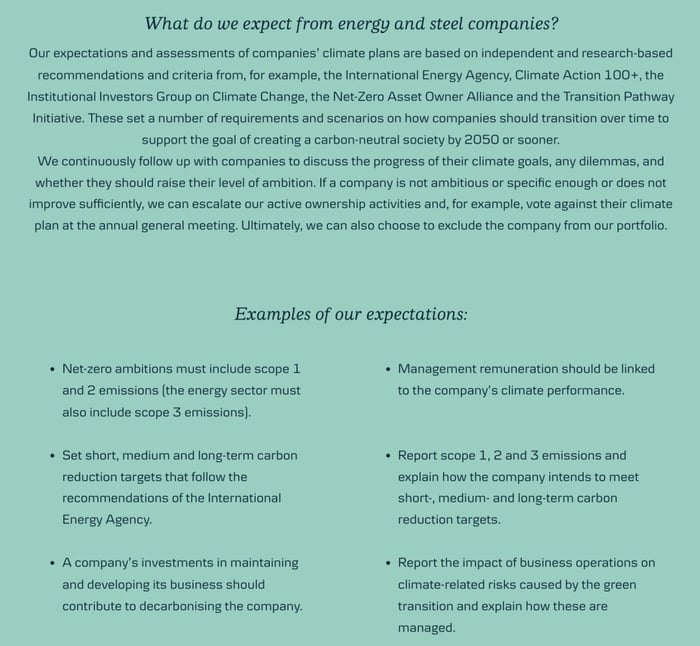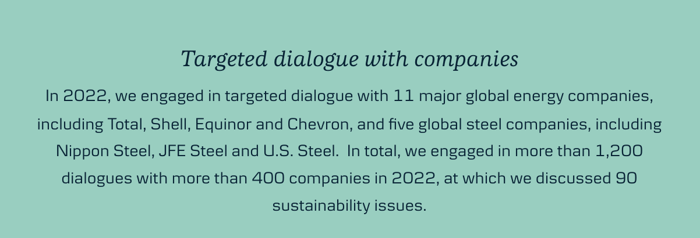Society must and will transition away from fossil energy, and companies must prepare for and contribute to driving this transition. These are the words of Quinn Lui, member of the investment team at Danica Pension. In 2022, Quinn Lui engaged in close dialogue with companies in the energy and steel sectors, and here she shares her thoughts on the green challenges facing these sectors and how she seeks to encourage them to develop ambitious climate plans.


INTERVIEW originally published by Danica Pension
Who do you talk to and why?
“I typically talk to those who are seated at the head of the table, from CEOs and CFOs to heads of sustainability. The dialogues serve two purposes. First of all, I gain in-depth knowledge about the company’s transition plans. We may cover issues like their development of renewable energy and other green alternatives, how they intend to implement climate technology or their plans for decarbonising their steel production. This allows us to better assess whether they are ambitious enough and geared to meeting the needs of the future, which is a prerequisite of being an attractive investment for us. Secondly, I regard our dialogue as a chance to discuss the companies’ transition plans and an opportunity to encourage them to move them in a more ambitious direction.”
Is it possible to get companies to take climate action through dialogue?
“Yes, definitely. It’s worth bearing in mind that, as an investor, Danica Pension owns a share of these companies. And companies generally want to appear attractive in order to gain access to capital, which they can use to run and expand their business. That’s why they’re interested in our opinion and any input we may have regarding their green transition, and this means that we can influence their approach. You could say that if they don’t listen and don’t adjust their operations, they’ll have a hard time attracting investors and raising capital – and that will be detrimental to their company. We also cooperate with other investors via, for example, the Climate Action 100+ initiative, in which we and more than 700 global investors try to inspire the most climate-damaging companies to curb emissions. When so many investors speak with one voice, the incentive to listen is greater.”

Did energy companies become more climate-friendly in 2022?
“The energy crisis and the war in Ukraine have turned the energy market upside down and challenged the green transition. Energy companies ramped up their fossil fuel production to fill the gap left by Russian oil and gas and to stabilise the economy. At the same time, soaring oil prices made it more financially attractive for energy companies to invest in more oil at the expense of renewable energy. This is a setback to the industry’s green transition in the short term and has made it more complex and challenging to navigate. On the one hand, we want to support a reliable energy supply to keep society running through the transition, and during this process the need for fossil fuels will continue. At the same time, we have a goal of reducing carbon emissions from our investments in the energy sector by 15% 2025, and this requires companies to reduce their use of fossil-based energy and replace it with greener alternatives. So we strongly encourage companies to follow the International Energy Agency’s net zero scenario, which constitute a roadmap for the different sectors’ compliance with the Paris Agreement. It’s a difficult balancing act. We aim to contribute to an ambitious and sensible transition, but we might need to make concessions the short term, as demonstrated by the energy crisis.”
Have energy companies improved in recent years?
“Some have improved – some more than others – and some have, among other things, set interim targets for their carbon emissions reduction or improved their plans for the green transition. However, the energy sector still has a long way to go. For example, energy companies have not aligned their plans for the green transition with the recommendations of the International Energy Agency, which is what we want them to do. In the short term, however, we know that other concerns also need to be addressed due to the energy crisis and to achieve our aim of ending our reliance on Russian oil.”
Is the energy sector ambitious enough?
“Different companies are at different stages, and many are aware that they need to do more. Our ambition is to put pressure on them to drive the green transition, which is why we continuously engage with the companies to discuss their progress as regards their climate targets and any dilemmas they may be facing, or whether they should raise their level of ambition. If we’re not satisfied with their progress, we can escalate our active ownership and, for example, vote against their climate plans at the annual general meetings, like we did recently with Equinor and Chevron, to increase the pressure on them. If they remain too unambitious, we can exclude them from our portfolio.
However, as a society, we must acknowledge that the transition is going to take time and that there are likely to be many bumps in the road along the way. For us, it’s about taking responsibility for transitioning the energy sector because this is essential in order to curb global warming. We are working determinedly to get companies to draw up climate plans that are in line with the recommendations of the International Energy Agency.”
Recently, we have also supported a lawsuit against Shell, with the aim of getting the company’s board of directors to prepare a climate plan that is in line with the International Energy Agency and that ensures that the company does not develop new oil-related projects. – Quinn Liu, Portfolio Manager, Danica Pension
What happens if companies increase oil production?
That is a dilemma because it goes against society’s ambition and our ambition to meet the targets of the Paris Agreement. In 2022, energy companies ramped up oil production from existing oil fields to help society end its reliance on Russian oil, but we expect them to reduce production again and increase their contribution to the green transition. They should not develop new oil projects but should increase production of renewable energy and other alternative green energy types as soon as possible: Also, they should install climate technologies in line with the International Energy Agency’s net-zero roadmap. We make this very clear to the companies through our dialogue, and at the annual general meetings we vote against companies’ climate plans if we feel the need to exert more pressure on them. Recently, we have also supported a lawsuit against Shell, with the aim of getting the company’s board of directors to prepare a climate plan that is in line with the International Energy Agency and that ensures that the company does not develop new oil-related projects. Our patience is not infinite, however, and if companies do not contribute enough to the transition or improve sufficiently over time, we may ultimately divest them.”

What is your view on the transition of the steel sector?
“The sector is facing major challenges. Today, virtually all steel production takes place using coke and coal to convert iron ore into steel. This produces high levels of carbon emissions, and to cut emissions companies install carbon capture technologies or replace coal-based furnaces with electric furnaces. However, this is not enough to seriously reduce the sector’s carbon footprint. New technologies, such as green hydrogen, can be used both as fuel and as part of the chemical process of turning ore into steel. Some companies are using the technology on a trial basis, but it’s not yet mature enough to be used on a large scale, and it’s not yet profitable.”
What will it take for the steel sector to take the next step?
“The big barriers are immature technologies, price and demand. Green hydrogen technology is in its infancy. Substantial investment is required to convert existing furnaces or build new ones that run on green hydrogen, and factories also need to be converted. Steel companies cannot bear these costs alone, and they are also dependent on the roll-out of green hydrogen in the energy market. The general attitude is that it will be difficult for the sector to raise the necessary capital to achieve the transition without any subsidies. It’s vital that we accelerate the development of green hydrogen to enable large-scale use. Doing so will reduce the price of green hydrogen and hopefully create increased demand for low-carbon emissions steel.”
What do you focus on in your dialogue with the steel companies?
“In the short term, my focus is to ensure that they implement existing technologies to reduce carbon emissions, and there’s still scope for improvement. I also spend a lot of time discussing the companies’ strategic considerations about when they will be able to introduce new technologies that will allow them to produce greener steel as we’re expecting the demand for green steel to increase over the next few years. For example, car manufacturers have introduced targets for the climate impact of cars, and they are interested in using low-carbon emissions steel, so this is an obvious opportunity for the steel companies.”
All opinions expressed are those of the author and/or quoted sources. investESG.eu is an independent and neutral platform dedicated to generating debate around ESG investing topics.
Published by
 investESG
investESG
 investESG
investESG

